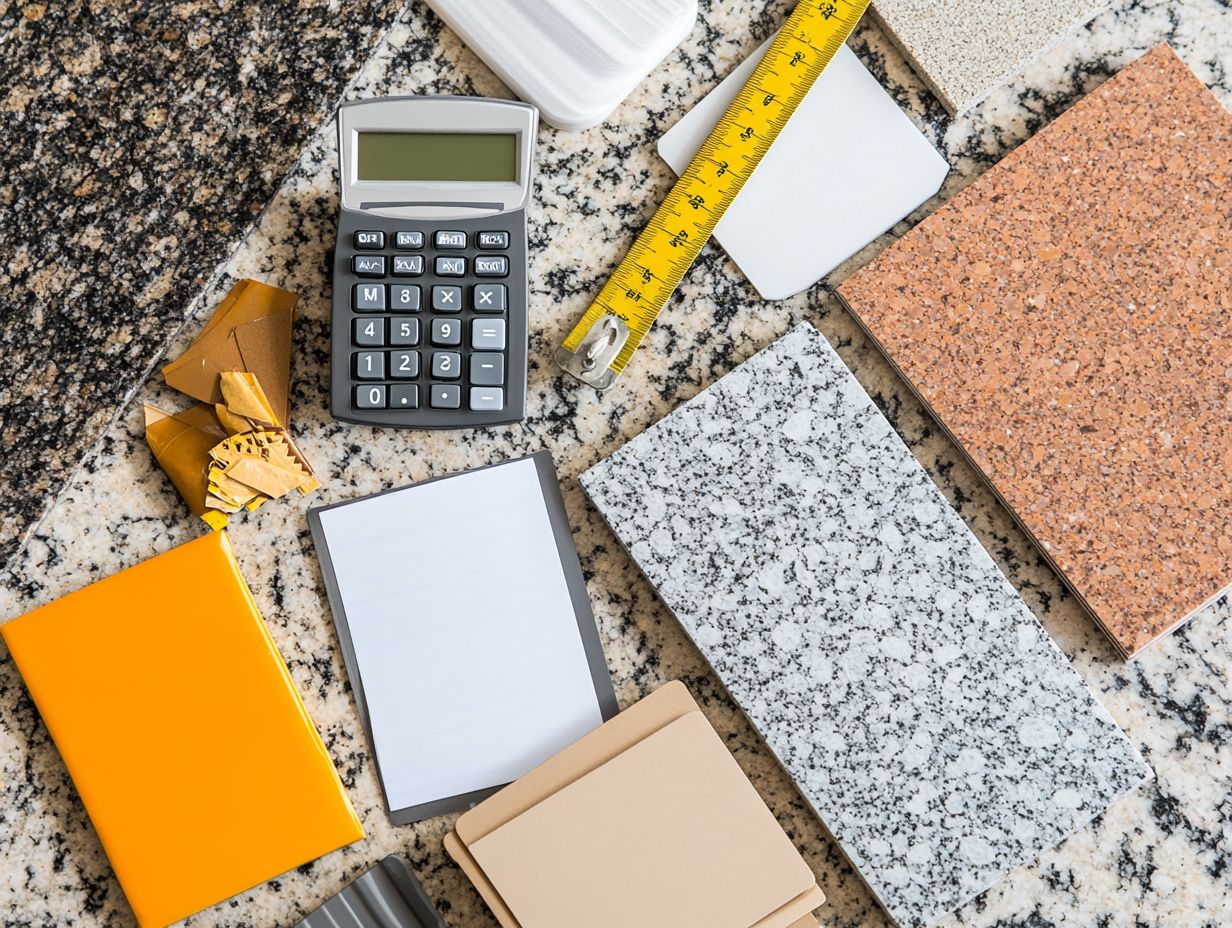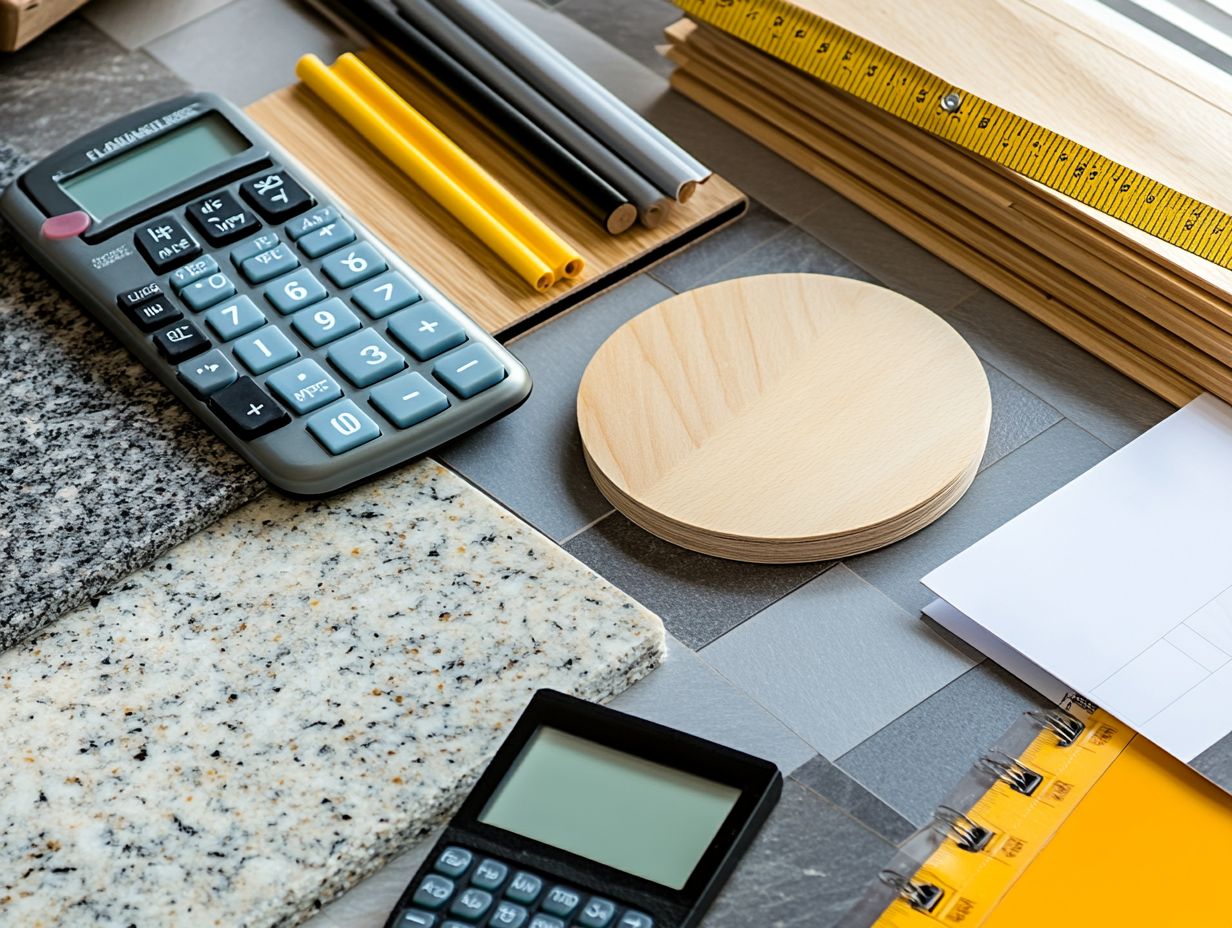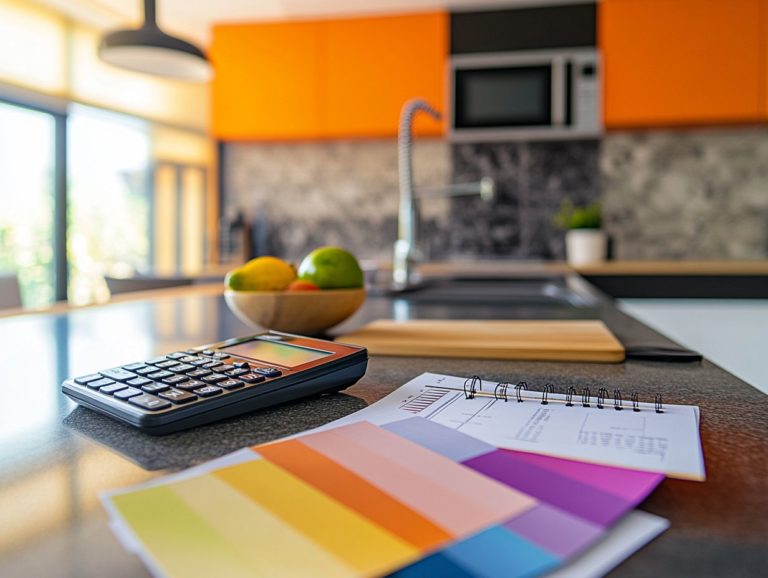5 Key Factors in Kitchen Remodeling Costs
Remodeling your kitchen can be both thrilling and intimidating, especially when it comes to understanding the costs involved.
Several factors play important roles in shaping your overall budget. These include the size and layout of your space, as well as the quality of materials and labor you choose. This article breaks down five key elements that influence kitchen remodeling costs, empowering you to navigate your project with confidence.
You will also discover ways to save money, pinpoint the most costly aspects, and explore popular trends that can inspire your dream kitchen.
Ready to create your dream kitchen? Let’s dive in!
Contents
- Key Takeaways:
- 1. Kitchen Size and Layout
- 2. Quality of Materials Used
- 3. Labor Costs
- 4. Complexity of Design
- 5. Additional Features and Upgrades
- What Is the Average Cost of a Kitchen Remodel?
- Frequently Asked Questions
- What are the 5 key factors that affect kitchen remodeling costs?
- How does the size of the kitchen impact the remodeling costs?
- What materials will impact the cost of your kitchen remodel?
- How do labor costs affect kitchen remodeling?
- What is involved in a kitchen remodeling project?
- Do appliances and fixtures impact remodeling costs?
Key Takeaways:

- Kitchen size and layout greatly impact remodeling costs. Larger spaces and intricate layouts require more materials and labor.
- The quality of materials used can significantly affect the overall cost of a kitchen remodel. Higher-quality options are typically more expensive.
- Labor costs can vary depending on the complexity of the project. It’s important to factor in the level of experience and expertise needed for the job.
1. Kitchen Size and Layout
The size and layout of your kitchen play important roles in shaping the entire remodeling journey. These aspects influence everything from kitchen functionality to the overall cost of renovations. They also affect the design elements you can incorporate into the space.
Whether your kitchen is small, medium, or large, understanding how these factors interact will empower you to create a beautiful and efficient environment tailored to your specific needs.
In smaller kitchens, making the most of every space is essential. This often leads to innovative design solutions, such as multi-functional furniture and vertical storage, enhancing both usability and aesthetic appeal.
Medium kitchens strike a harmonious balance. They allow for more elaborate layouts and a broader array of storage options, while still keeping a keen eye on budget constraints.
On the other hand, large kitchens offer a canvas for creativity. However, with that ample space comes higher remodeling costs and the challenge of maintaining a cohesive design.
Each size category not only dictates how space is utilized but also influences customization potential. It’s important to think about these factors during the planning stages of your kitchen renovation.
2. Quality of Materials Used
The quality of materials you choose for your kitchen remodel can dramatically influence both aesthetics and overall cost. This affects everything from cabinetry and countertops to flooring options and lighting expenses.
Selecting the right materials is crucial for achieving the desired look and feel of your space. It also ensures durability and longevity. For instance, solid wood cabinetry provides timeless appeal, while laminate offers a polished yet budget-friendly alternative.
Regarding countertops, granite is often praised for its beauty and durability, whereas quartz delivers a similar aesthetic without the upkeep concerns. Your flooring choices are equally diverse; luxury vinyl planks can mimic the look of hardwood but at a fraction of the cost, making them an excellent option if you’re on a tight budget.
Every material selection significantly impacts the overall design, underscoring the importance of aligning your style preferences with financial considerations for a successful kitchen update.
3. Labor Costs
Labor costs play a crucial role in any kitchen remodel. They often represent a substantial portion of your total expenses. This includes installation labor, plumbing services, and electrical work essential for a seamless kitchen transformation.
The overall labor expense can vary dramatically based on factors such as project complexity, skill level required for specific tasks, and regional labor rates. If you’re leaning toward intricate designs or custom cabinetry, expect to engage more skilled labor, which naturally leads to higher costs.
Hiring certified professionals ensures compliance with building codes and elevates the quality of workmanship. This guarantees your long-term satisfaction.
You can save on labor costs by meticulously planning your project, opting for simpler designs, and considering off-peak seasons for renovations. Diligently researching and obtaining multiple quotes will empower you to discover competitive pricing while maintaining quality.
Don’t wait—start planning your kitchen remodel today!
4. Complexity of Design

The complexity of your kitchen design shapes your remodeling budget and enhances functionality. It integrates features that influence both aesthetics and daily use.
Choose a minimalistic layout with clean lines or an intricate design featuring elaborate cabinetry. Each decision is crucial in crafting your kitchen environment.
Modern appliances, like smart refrigerators and energy-efficient ovens, boost your kitchen’s appeal. They also lead to significant savings on utility bills.
Your choice of materials impacts maintenance and durability. This affects your investment and the longevity of the remodel.
Thoughtful design complexity can help you create a functional space tailored to your needs.
5. Additional Features and Upgrades
Adding features and upgrades to your kitchen can boost functionality and charm. This ultimately increases your kitchen’s value and enhances your experience.
Smart appliances offer advanced convenience, becoming popular among homeowners who value efficiency. Think about innovative storage options like pull-out shelves and deep drawers that keep everything organized.
Upgraded fixtures, from sleek faucets to elegant cabinet handles, elevate your kitchen’s look. They also improve durability and usability, shaping current kitchen trends.
With a variety of upgrades available, you can find options that fit your budget and preferences. This makes it possible for every homeowner to create their dream kitchen.
What Is the Average Cost of a Kitchen Remodel?
The average kitchen remodel cost varies significantly. Factors include kitchen size, material quality, and design complexity.
For a small kitchen, you might start at around $10,000 for cosmetic updates. A full remodel could cost $25,000 or more, depending on your material choices.
Medium kitchen updates generally range from $20,000 to $50,000. Larger spaces may exceed $75,000 for complete transformations.
Don’t overlook labor costs. Skilled professionals are essential for intricate designs and quality finishes. Consider how each element impacts your overall budget.
How Can One Save on Kitchen Remodeling Costs?
Saving on kitchen remodeling can transform your budget. You can achieve your dream kitchen without overspending.
With strategic planning and smart shopping, you can navigate the remodeling process. Evaluate your project scope to identify where to cut costs.
DIY projects cut labor costs and add a personal touch. Choosing cost-effective materials like laminate instead of granite can also help save money.
Timing your renovations during off-peak seasons can lower prices on labor and materials. A comprehensive budget will protect you from unexpected costs.
What Are the Most Expensive Aspects of Kitchen Remodeling?

Transform your kitchen into a dream space! Understanding the most significant costs associated with kitchen remodeling will empower you to plan your budget effectively.
Cabinetry and countertop choices often top the list of financial considerations that can stretch any remodeling budget. By recognizing these key elements, you can make informed decisions that balance quality and cost.
Kitchen cabinetry usually represents a big part of your budget. Options range from stock selections to custom designs.
Countertops, crafted from materials like granite or quartz, can dramatically enhance the overall aesthetic while also impacting the price tag.
The cost of hiring workers is another critical aspect to consider. To manage these expenses, explore alternative materials, hunt for deals, or even roll up your sleeves to handle some parts of the remodel yourself if you possess the skills and time.
Consider exploring financing options to ease financial strain during your remodel.
How Can One Determine Their Budget for a Kitchen Remodel?
Determining a budget for your kitchen remodel begins with a thoughtful assessment of your current kitchen needs. Consider the features you desire and the overall cost required to realize your renovation goals while ensuring that your remodel remains financially feasible.
Start by listing the specific changes that are essential for your vision. This may involve upgrading appliances, installing new countertops, or reconfiguring the layout for enhanced functionality.
Once you’ve identified these needs, gather estimates for each element of the remodel. Consulting with contractors can offer valuable insights into the potential costs associated with materials and labor.
As you outline your budget, it’s prudent to include a buffer for unexpected expenses—think structural surprises or delays in delivery.
A well-structured financial plan not only steers the remodeling process but also empowers you to make informed decisions that harmonize your aesthetic aspirations with financial realities.
What Are the Most Popular Kitchen Remodeling Trends?
Staying informed about the latest kitchen remodeling trends can empower you to make design choices that enhance the aesthetics of your kitchen. These choices seamlessly incorporate modern appliances and innovative solutions tailored to your contemporary lifestyle needs.
For example, the trend toward open layouts fosters connectivity among family members and maximizes natural light, creating a warm and inviting atmosphere.
You may be drawn to eco-friendly materials like reclaimed wood and bamboo, which contribute to sustainability while adding unique character and warmth to your space.
Furthermore, embracing technology integration is essential. Smart appliances and touchless faucets are becoming increasingly popular for their convenience and efficiency.
Styles such as minimalism and industrial chic continue to capture attention, providing a range of aesthetics that align beautifully with your personal taste.
Frequently Asked Questions
What are the 5 key factors that affect kitchen remodeling costs?

The 5 key factors that affect kitchen remodeling costs are the size of the kitchen, materials used, labor costs, the scope of the project, and additional features such as appliances and fixtures.
How does the size of the kitchen impact the remodeling costs?
The size of the kitchen is a major factor in determining the cost of a kitchen remodel. It directly affects the amount of materials and labor needed.
A larger kitchen will require more materials and labor, resulting in a higher overall cost.
What materials will impact the cost of your kitchen remodel?
The materials used in a kitchen remodel can greatly impact the cost. High-end materials such as granite countertops and custom cabinetry will be more expensive than budget-friendly options like laminate countertops and stock cabinets.
How do labor costs affect kitchen remodeling?
Labor costs vary based on the project’s complexity and the professionals’ experience.
It’s essential to include these costs in your budget.
What is involved in a kitchen remodeling project?
The scope of a kitchen remodel defines the changes made.
Simple updates like new countertops will cost less than a complete redesign.
Do appliances and fixtures impact remodeling costs?
Yes, appliances and fixtures can greatly increase your remodeling costs.
Opting for high-end brands will raise your budget, while choosing budget-friendly options will help keep costs down.





